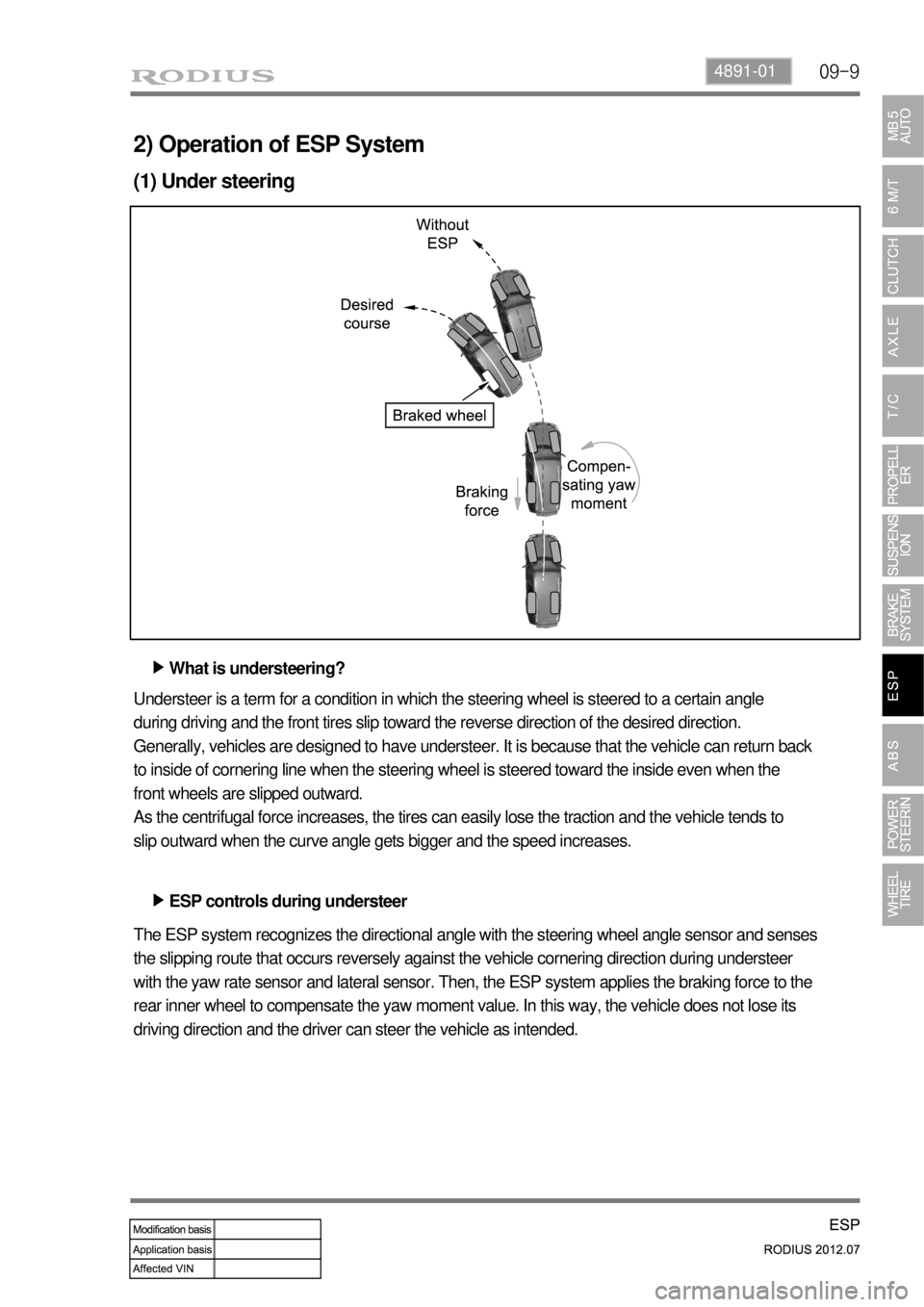Page 613 of 715
09-54891-01
1. ESP (Electronic Stability Program)
ESP system contains the ABS (Anti-Lock Brake System), ABD (Automatic Braking Differential),
ASR (Acceleration Slip Regulation), Cornering Control and HBA (Hydraulic Brake Assist System)
functions.
▶Cornering Control (Understeer and Overersteer) Function
This function controls the vehicle stability by applying the braking pressure on each wheel
according to the yaw rate, lateral sensing value and driver’s steering wheel control.
▶HBA (Hydraulic Brake Assist System) Function
HBA (Hydraulic Brake Assist) system helps in an emergency braking situation when the driver
applies the brake fast, but not with sufficient pressure, which leads to dangerously long braking
distance. ECU recognizes the attempt at full braking and transmits the signal calling for full brake
pressure from the hydraulic booster.
Page 614 of 715
09-6
HECU(Hydraulic & Electronic Control Unit)
ESP ABS
2. LAYOUT
Name ESP ABS Location
1 HECU O O Under the battery
2 Pressure Sensor O X Under the master cylinder
3 Wheel Speed Sensor O O On wheels
4 Sensor Cluster O X Under the audio assembly
5 Steering Wheel Angle Sensor O X Under the steering wheel
Pressure Sensor
Installed Removed
Page 615 of 715
09-74891-01
1. ESP Indicator2. Steering Wheel Angle
Sensor
3. ESP OFF Switch 4. Sensor Cluster
Front Wheel Speed Sensor
4WD 2WDRear Wheel Speed
Sensor
Page 617 of 715

09-94891-01
2) Operation of ESP System
(1) Under steering
What is understeering? ▶
ESP controls during understeer ▶ Understeer is a term for a condition in which the steering wheel is steered to a certain angle
during driving and the front tires slip toward the reverse direction of the desired direction.
Generally, vehicles are designed to have understeer. It is because that the vehicle can return back
to inside of cornering line when the steering wheel is steered toward the inside even when the
front wheels are slipped outward.
As the centrifugal force increases, the tires can easily lose the traction and the vehicle tends to
slip outward when the curve angle gets bigger and the speed increases.
The ESP system recognizes the directional angle with the steering wheel angle sensor and senses
the slipping route that occurs reversely against the vehicle cornering direction during understeer
with the yaw rate sensor and lateral sensor. Then, the ESP system applies the braking force to the
rear inner wheel to compensate the yaw moment value. In this way, the vehicle does not lose its
driving direction and the driver can steer the vehicle as intended.
Page 618 of 715
09-10
(2) Over steering
What is oversteering? ▶
ESP controls during oversteer ▶ Oversteer is a term of a condition in which the steering wheel is steered to a certain angle during
driving and the rear tires slip outward losing traction.
Compared to understeering vehicles, it is hard to control the vehicle during cornering and the
vehicle can spin due to rear wheel moment when the rear tires lose traction and the vehicle speed
increases.
The ESP system recognizes the directional angle with the steering wheel angle sensor and senses
the slipping route that occurs towards the vehicle cornering direction during oversteer with the
yaw rate sensor and lateral sensor. Then the ESP system applies the braking force to the front
outer wheel to compensate the yaw moment value. In this way, the vehicle does not lose its
driving direction and the driver can steer the vehicle as intended.
Page 619 of 715
09-114891-01
(3) ESP Control
The ESP (Electronic Stability Program) has been developed to help a driver avoid danger of losing
control of the vehicle stability due to understeer or oversteer during cornering. The yaw rate sensor,
lateral sensor and longitudinal sensor in the sensor cluster and the steering wheel angle sensor
under the steering column detect the vehicle conditions when the inner or outer wheels are
spinning during oversteer, understeer or cornering. The ESP ECU controls against oversteer or
understeer during cornering by controlling the vehicle stability using input values from these
sensors and applying the braking force to the corresponding wheels independently. The system
also controls the engine power right before the wheel spin synchronized to decelerate the vehicle
automatically in order to maintain the vehicle stable during cornering.
Page 620 of 715
09-12
(4) Vehicle Control During Cornering
The figure below shows the vehicle controls by the ESP system under various situations such as
when the brake pedal is depressed or not depressed during cornering, when the ABS is operating
and when braking without the ABS. It also includes the vehicle conditions when the TCS, a part of
the ESP system, is operating.
Condition Understeer control Oversteer control
Only ESP in
operation
No braking by
driver
ESP
+
Normal braking
(no ABS operation)
ESP
+
ABS brake
ESP + ASR
Page 622 of 715
09-14
(2) Operation
The brake pressure value and the changed value of the pressure sensor are the conditions in
which the HBA System operates. There are 2 pressure sensors under the master cylinder. When
the ESP ECU system determines that emergency braking is present, the pump operates, the
brake fluid in the master cylinder is sent to the pump and the braking pressure is delivered to the
wheels via the inlet valves.
If the drive depress the brake pedal slowly, the pressure change is not high. In this case, only the
conventional brake system with booster is activated.